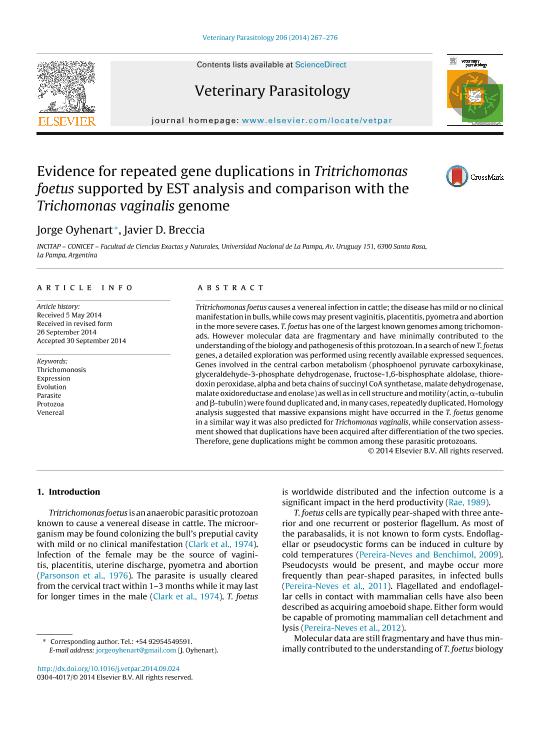Artículo
Evidence for repeated gene duplications in Tritrichomonas foetus supported by EST analysis and comparison with the Trichomonas vaginalis genome
Fecha de publicación:
12/2014
Editorial:
Elsevier Science
Revista:
Veterinary Parasitology
ISSN:
0304-4017
Idioma:
Inglés
Tipo de recurso:
Artículo publicado
Clasificación temática:
Resumen
Tritrichomonas foetus causes a venereal infection in cattle; the disease has mild or no clinical manifestation in bulls, while cows may present vaginitis, placentitis, pyometra and abortion in the more severe cases. T. foetus has one of the largest known genomes among trichomonads. However molecular data are fragmentary and have minimally contributed to the understanding of the biology and pathogenesis of this protozoan. In a search of new T. foetus genes, a detailed exploration was performed using recently available expressed sequences. Genes involved in the central carbon metabolism (phosphoenol pyruvate carboxykinase, glyceraldehyde-3-phosphate dehydrogenase, fructose-1,6-bisphosphate aldolase, thioredoxin peroxidase, alpha and beta chains of succinyl CoA synthetase, malate dehydrogenase, malate oxidoreductase and enolase) as well as in cell structure and motility (actin, α-tubulin and β-tubulin) were found duplicated and, in many cases, repeatedly duplicated. Homology analysis suggested that massive expansions might have occurred in the T. foetus genome in a similar way it was also predicted for Trichomonas vaginalis, while conservation assessment showed that duplications have been acquired after differentiation of the two species. Therefore, gene duplications might be common among these parasitic protozoans.
Palabras clave:
Thrichomonosis
,
Expression
,
Evolution
,
Protozoa
,
Parasitae
,
Venereal
Archivos asociados
Licencia
Identificadores
Colecciones
Articulos(INCITAP)
Articulos de INST.D/CS D/L/TIERRA Y AMBIENTALES D/L/PAMPA
Articulos de INST.D/CS D/L/TIERRA Y AMBIENTALES D/L/PAMPA
Citación
Oyhenart, Jorge; Breccia, Javier Dario; Evidence for repeated gene duplications in Tritrichomonas foetus supported by EST analysis and comparison with the Trichomonas vaginalis genome; Elsevier Science; Veterinary Parasitology; 206; 3-4; 12-2014; 267-276
Compartir
Altmétricas




